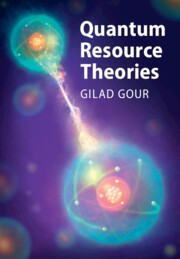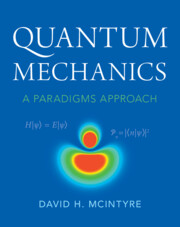Refine search
Actions for selected content:
45 results
3 - Thermodynamics without Time
- from Part I - Local Systems
-
-
- Book:
- The Arrow of Time
- Published online:
- 28 October 2025
- Print publication:
- 30 October 2025, pp 56-70
-
- Chapter
- Export citation
8 - Time for Pancakes: Time Reversal and Ontology
- from Part III - The Arrow of Time and Time-Reversal Invariance
-
-
- Book:
- The Arrow of Time
- Published online:
- 28 October 2025
- Print publication:
- 30 October 2025, pp 161-183
-
- Chapter
- Export citation
1 - Physical Preliminaries
- from Part I - Physical and Mathematical Background
-
- Book:
- Causal Fermion Systems
- Published online:
- 15 November 2025
- Print publication:
- 23 October 2025, pp 3-20
-
- Chapter
-
- You have access
- Open access
- Export citation
TEAM SEMANTICS AND INDEPENDENCE NOTIONS IN QUANTUM PHYSICS
- Part of
-
- Journal:
- Bulletin of Symbolic Logic , First View
- Published online by Cambridge University Press:
- 15 August 2025, pp. 1-54
-
- Article
-
- You have access
- Open access
- HTML
- Export citation
4 - Angular and Career Momentum: What Lucy Mensing Contributed to Physics and Why She Left the Field
-
-
- Book:
- Women in the History of Quantum Physics
- Published online:
- 02 July 2025
- Print publication:
- 19 June 2025, pp 102-148
-
- Chapter
- Export citation
11 - From Quantum Physics to Ethics: Grete Hermann on Heisenberg’s Cut
-
-
- Book:
- Women in the History of Quantum Physics
- Published online:
- 02 July 2025
- Print publication:
- 19 June 2025, pp 309-336
-
- Chapter
- Export citation

Quantum Resource Theories
-
- Published online:
- 03 May 2025
- Print publication:
- 10 April 2025
9 - The Role of Quaternions in Rotation Theory
-
- Book:
- Rotation Sequences and the Theory of Vectors and Coordinates
- Published online:
- 17 April 2025
- Print publication:
- 24 April 2025, pp 260-302
-
- Chapter
- Export citation
2 - Elements of Quantum Mechanics I: Closed Systems
- from Part I - Preliminaries
-
- Book:
- Quantum Resource Theories
- Published online:
- 03 May 2025
- Print publication:
- 10 April 2025, pp 23-74
-
- Chapter
- Export citation
1 - Introduction
-
- Book:
- Quantum Models of Cognition and Decision
- Published online:
- 14 November 2024
- Print publication:
- 21 November 2024, pp 1-20
-
- Chapter
- Export citation
8 - Compromising with Hitler
- from Part II - Living with the Bomb
-
- Book:
- Hitler's Atomic Bomb
- Published online:
- 18 July 2024
- Print publication:
- 18 July 2024, pp 179-214
-
- Chapter
- Export citation
In Lieu of the Concluding Remarks
-
- Book:
- The Non-Coherence Theory of Digital Human Rights
- Published online:
- 22 February 2024
- Print publication:
- 29 February 2024, pp 293-310
-
- Chapter
- Export citation
Project 1: - Rectangular Finite Quantum Well – Stationary Schrödinger Equation in 1D
-
- Book:
- A First Guide to Computational Modelling in Physics
- Published online:
- 01 February 2024
- Print publication:
- 08 February 2024, pp 1-6
-
- Chapter
-
- You have access
- Export citation
8 - Method of Quantum Field Theory
- from Part II - Theoretical Backgrounds
-
- Book:
- Field Theory of Multiscale Plasticity
- Published online:
- 14 December 2023
- Print publication:
- 04 January 2024, pp 416-436
-
- Chapter
- Export citation

Quantum Mechanics
- A Paradigms Approach
-
- Published online:
- 11 February 2023
- Print publication:
- 15 September 2022
-
- Textbook
- Export citation
Existential Bias
-
- Article
- Export citation
1 - A Short Primer on Quantum Mechanics
- from Part I - First-Principles Calculations
-
- Book:
- Introduction to Computational Nanomechanics
- Published online:
- 12 October 2022
- Print publication:
- 08 December 2022, pp 3-34
-
- Chapter
- Export citation
3 - Basic Concepts of Quantum Mechanics
-
- Book:
- Semiconductor Laser Photonics
- Published online:
- 10 November 2022
- Print publication:
- 24 November 2022, pp 69-97
-
- Chapter
- Export citation
2 - Quantum Mechanics
-
- Book:
- Quantum Information and Quantum Optics with Superconducting Circuits
- Published online:
- 04 August 2022
- Print publication:
- 18 August 2022, pp 7-18
-
- Chapter
- Export citation
8 - Attractors and Quantum Mechanics
-
- Book:
- Attractors of Hamiltonian Nonlinear Partial Differential Equations
- Published online:
- 17 September 2021
- Print publication:
- 30 September 2021, pp 192-199
-
- Chapter
- Export citation
